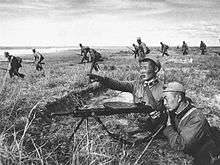Mongolia in World War II


Mongolian People's Republic was one of the minor allies of the Soviet Union during the World War II. Through most of the war, Mongolia kept formal neutrality but this ended in the closing days of World War II.[1] Throughout the war, the country provided the Soviet Union with economical support, such as livestock, raw materials, money, food, and military clothing,[1] to its military efforts in combating Nazi Germany and was directly involved in the war against the Empire of Japan at the Battles of Khalkhin Gol in May 1939 and other Soviet–Japanese border conflicts.[2]
History
In 1934, the Soviet Union and Mongolia reached a gentlemen's agreement that provided for mutual assistance in the face of Japanese advances in Manchuria and Inner Mongolia.[1] Two reached formal Mongolian-Soviet Treaty of Friendship on 12 March 1936.[1] The primary reason for the Soviet Union to sign the agreement with the Mongolian People's Republic was to protect the security of its Trans-Siberian Railway.[3] At the time of war, Outer Mongolia had less than a million inhabitants.[4]
Landlocked Mongolia got to the point of military engagement since the expansionist Japanese invasion of Manchuria during the Second Sino-Japanese War brought the Imperial Japanese Army to its borders. International recognition of the Mongolian People's Republic was limited at that time since the Republic of China claimed it to be part of its own territory,[1] and the Mongolian People's Republic was seen as a Soviet satellite state similar to the Tuvan People's Republic.[3] The modern day Chinese autonomous region of Inner Mongolia was under Japanese occupation during the war as a part of Mengjiang, a puppet state in Northeast China. When the last campaign of the Second World War, the Soviet invasion of Manchuria, was initiated in August 1945, the Mongolian People's Army fought on the Soviet side.
Today, the Zaisan Memorial in the southern area of the Mongolian capital of Ulaanbaatar honors the Soviet soldiers killed in World War II.
References
- 1 2 3 4 5 Robert L. Worden and Andrea Matles Savada (ed.). "Mongolia: A Country Study-Economic Gradualism and National Defense, 1932-45". Claitor's Pub Division. Retrieved 27 November 2016.
- ↑ "World War II: Soviet and Japanese Forces Battle at Khalkhin Gol". HistoryNet.com. Retrieved 27 November 2016.
- 1 2 "Japanese-Soviet Manchurian-Mongolian Border War: Khalkhin Gol (May-September 1939)". Retrieved 27 November 2016.
- ↑ ""Mongolia in World War II-1945"". Ньюс аженси. Retrieved 27 November 2016.
See also
- Manchuria under Qing rule
- Sino-Soviet relations
- China–Mongolia relations
- Japan–Mongolia relations
- Soviet–Japanese War (1945)
- Outer Mongolia
- Mongolian Revolution of 1921
- Mongolia–United States relations